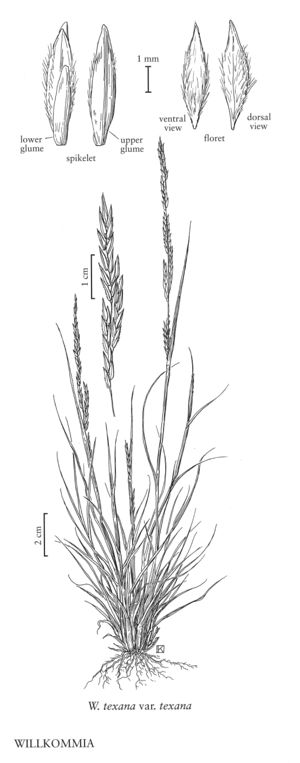Difference between revisions of "Willkommia texana"
imported>Volume Importer |
GeoffLevin (talk | contribs) m (Add period to Hitchc. in authority) |
||
| Line 1: | Line 1: | ||
{{Treatment/ID | {{Treatment/ID | ||
|accepted_name=Willkommia texana | |accepted_name=Willkommia texana | ||
| − | |accepted_authority=Hitchc | + | |accepted_authority=Hitchc. |
|publications= | |publications= | ||
|common_names=Willkommia | |common_names=Willkommia | ||
| Line 26: | Line 26: | ||
-->{{#Taxon: | -->{{#Taxon: | ||
name=Willkommia texana | name=Willkommia texana | ||
| − | |authority=Hitchc | + | |authority=Hitchc. |
|rank=species | |rank=species | ||
|parent rank=genus | |parent rank=genus | ||
Latest revision as of 17:46, 8 December 2021
Plants perennial; cespitose or stoloniferous. Culms (12)17-65 cm, glabrous; nodes 4-6(7), glabrous. Leaves cauline; sheaths mostly glabrous, upper margins sometimes pubescent; ligules 0.3-0.6 mm, truncate; blades (1)4-21 cm long, 0.6-3.5 mm wide, involute to flat, glabrous, margins pubescent. Panicles (6)7-34(44) cm long, 4-10 mm wide; branches 4-13(20), 1-8 cm, appressed, each branch usually terminating in a reduced, sterile spikelet, lowest branches usually partially enclosed in the uppermost sheaths at maturity. Spikelets 3.5-5 mm; disarticulation usually below the glumes, sometimes the first glume persistent. Lower glumes 2-3.5 mm, glabrous; upper glumes 3.3-4.8 mm, glabrous and smooth below, scabridulous above; lemmas 3.0-4.2 mm, usually appressed pilose between the veins, lateral veins obscure, midveins sometimes excurrent; paleas 2.5-3.4 mm, pubescent between the veins; anthers 3, 0.3-0.9(1.1) mm, yellow-orange. Caryopses 1.4-2 mm. 2n = 60.
Discussion
Willkommia texana grows on clay pans, alkaline flats, and sandy soils, in open or bare areas of Texas and (rarely) Oklahoma and, as a disjunct, in Argentina. The Oklahoma record may represent a recent introduction. North American plants belong to Willkommia texana Hitchc. var. texana. They differ from the Argentinean variety, W. texana var. stolonifera Parodi, in being cespi¬tose rather than stoloniferous.
Selected References
None.
